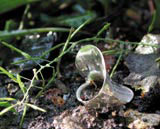Artistic licence
Adrian Shaughnessy takes a look at the work of final-year 2D students at the Royal College of Art, who enjoy the freedom to blur the lines between art and graphic design,

‘The students design the course,’ says Arad. ‘We do not attempt to define design or any process, they find their own process’. And that is apparent all through the work of these passionate people from all countries and disciplines. Never more so than Tom Vaughan and Will Smith, who, in the middle of this eclectic brilliance, have designed a metal frame rotation-moulding machine. Cold set resin is then poured into the cheapest of moulding materials (usually a shaped, inflated PVC bag) to create surprising and beautiful furniture. They’ve developed chairs and tables with unique forms. Cheap and breathtakingly simple, their process creates a whole new form of furniture, so cheap a school or hospital could make their own.
The RCA defines the design of human interaction with objects and technology in three ways: design products, industrial design engineering and interaction design. It is the background of the students that differs: where Design Products has industrial design, furniture and architectural students, Industrial Design Engineering takes most of its intake from engineering courses.
But Interaction Design has no automatic entry perspective. Formed from the computer-related design course, it has been run for two years by Professor Irene McAra-McWilliam and mixes fine artists, technology experts and architects. Interaction Design is focused on our relationship with technology, the computer and increasingly the mobile phone. The ubiquity, mobility and intelligence of technology provides as many threats as it does opportunities, and courses such as this and the one in Ivrea in northern Italy, which is run by former head of the RCA course Professor Gillian Crampton-Smith, do pioneering work which pushes our under- standing of what is possible and acceptable.
Abi Durrant has created a dream jar, which records your immediate waking thoughts, then wipes them each day. Christian Nold is interested in how mobiles leave traces of emotion behind, so that others might track locations where excitement, or fear, is felt. Toke Barter plays with ferro-magnetic fluids that react to magnetism to create shapes, symbols and type. James Davies’ Oh! combines mechanical sensation with electrical control to create the ultimate artefact to assist in artificial insemination.
The degree course is a marker of progress for students who have chosen to use this unique space and intellectual environment. As Arad puts it, ‘There isn’t any better place.’
The student shows are held at The Royal College of Art, Kensington Gore, London SW7 from 25 June to 4 July, 10-6pm, with late night opening on 25 June and 1 July (until 10pm)
The RCA will be closed to the public on 2 July
-
Post a comment




